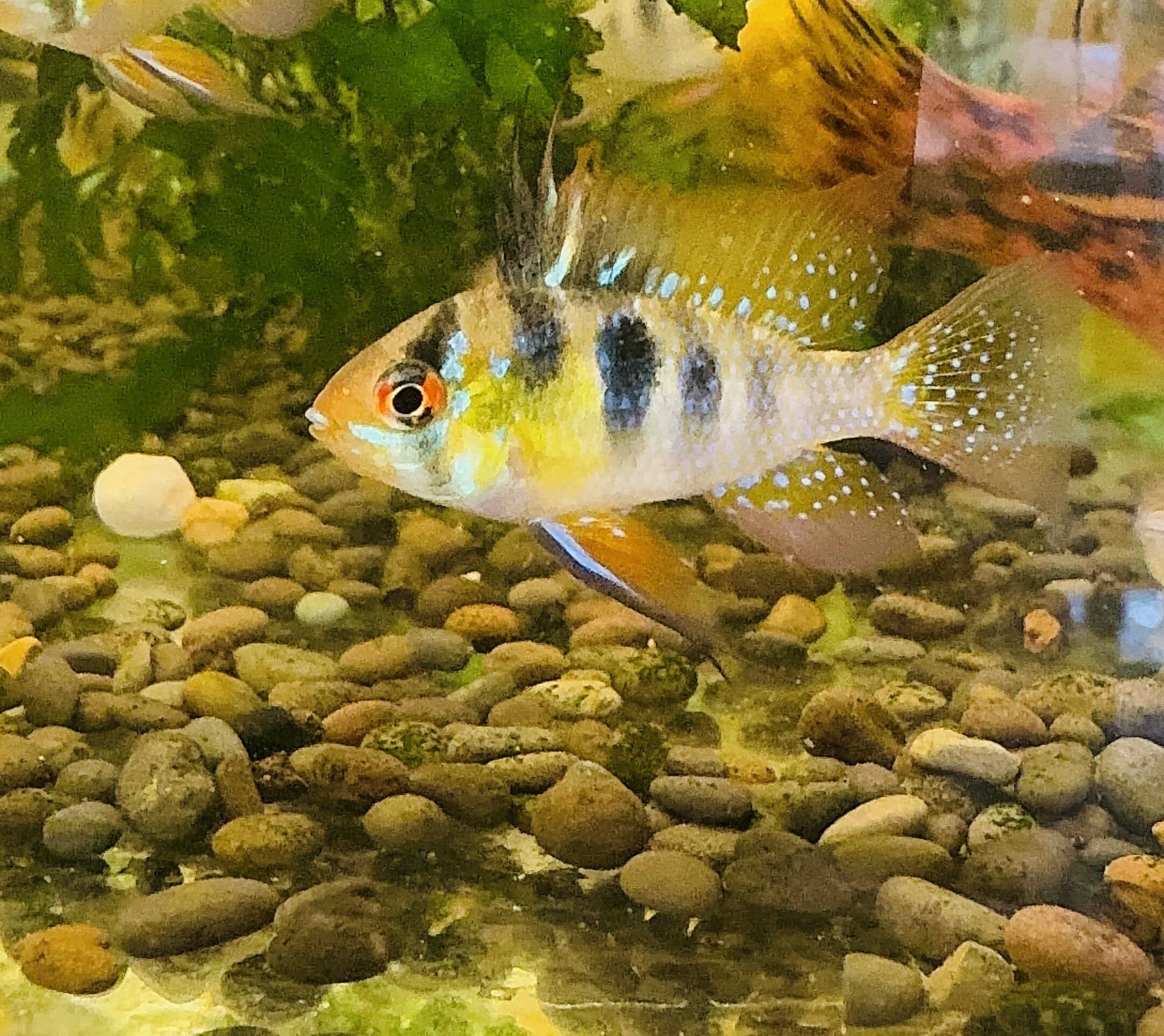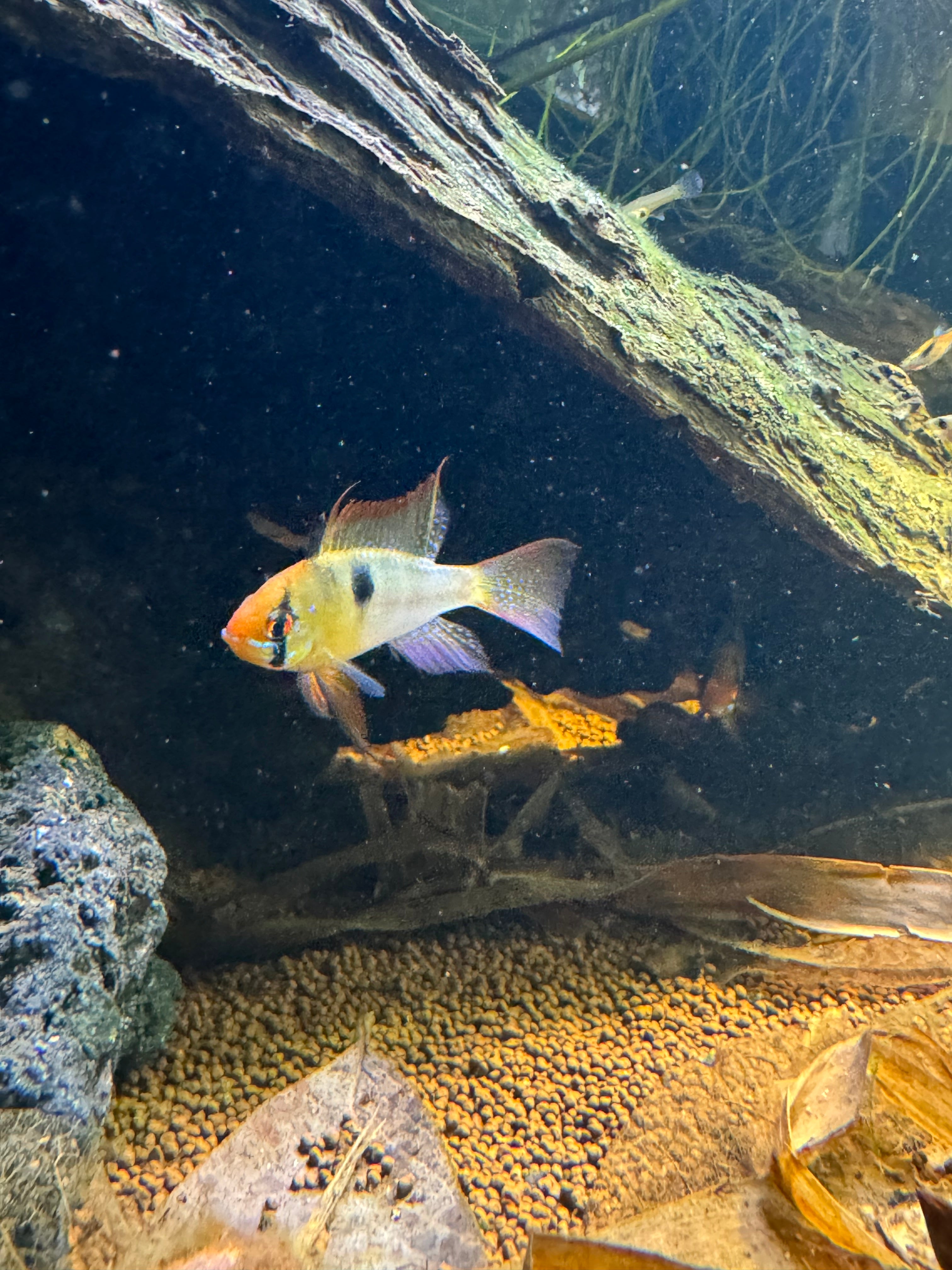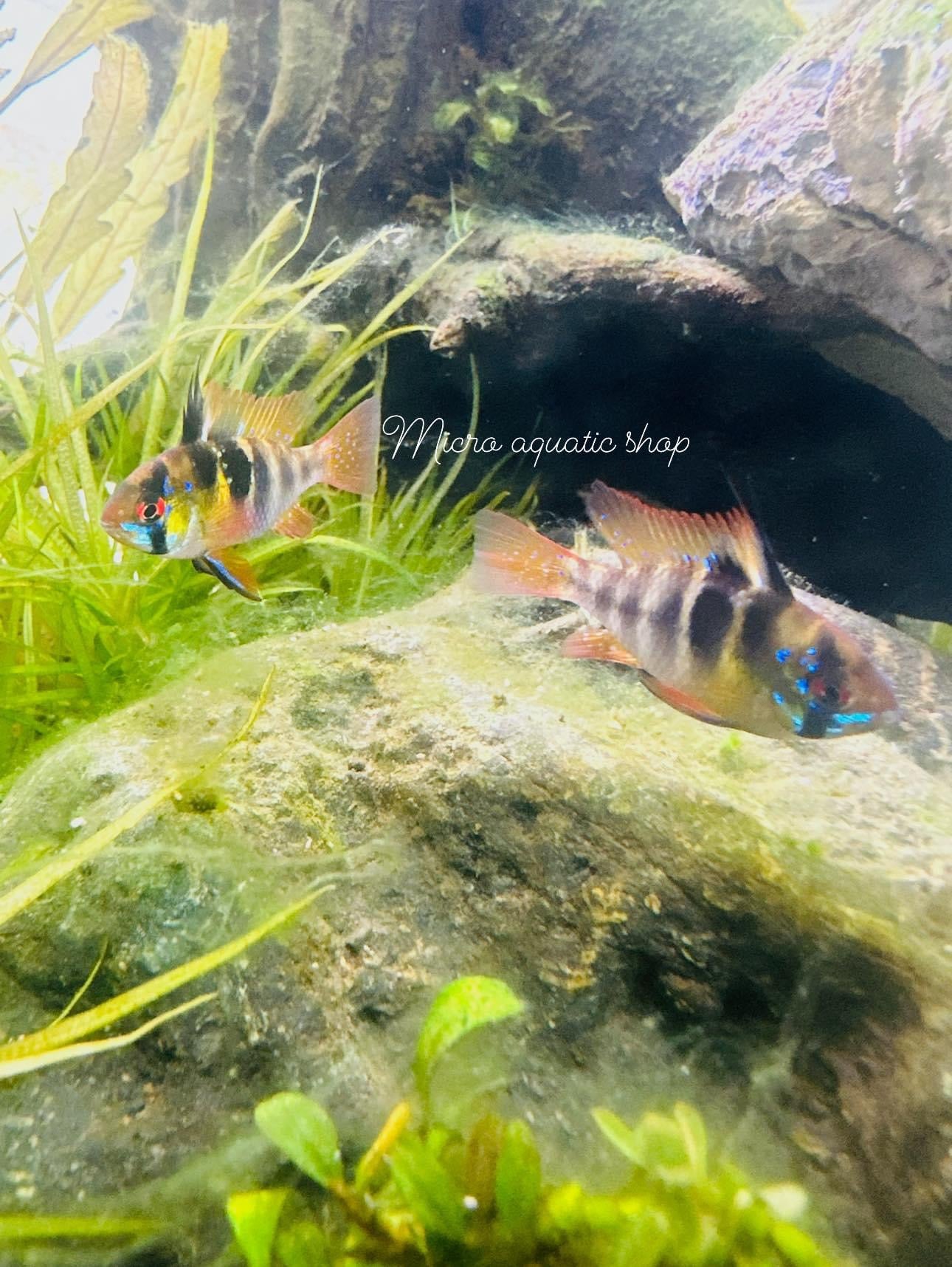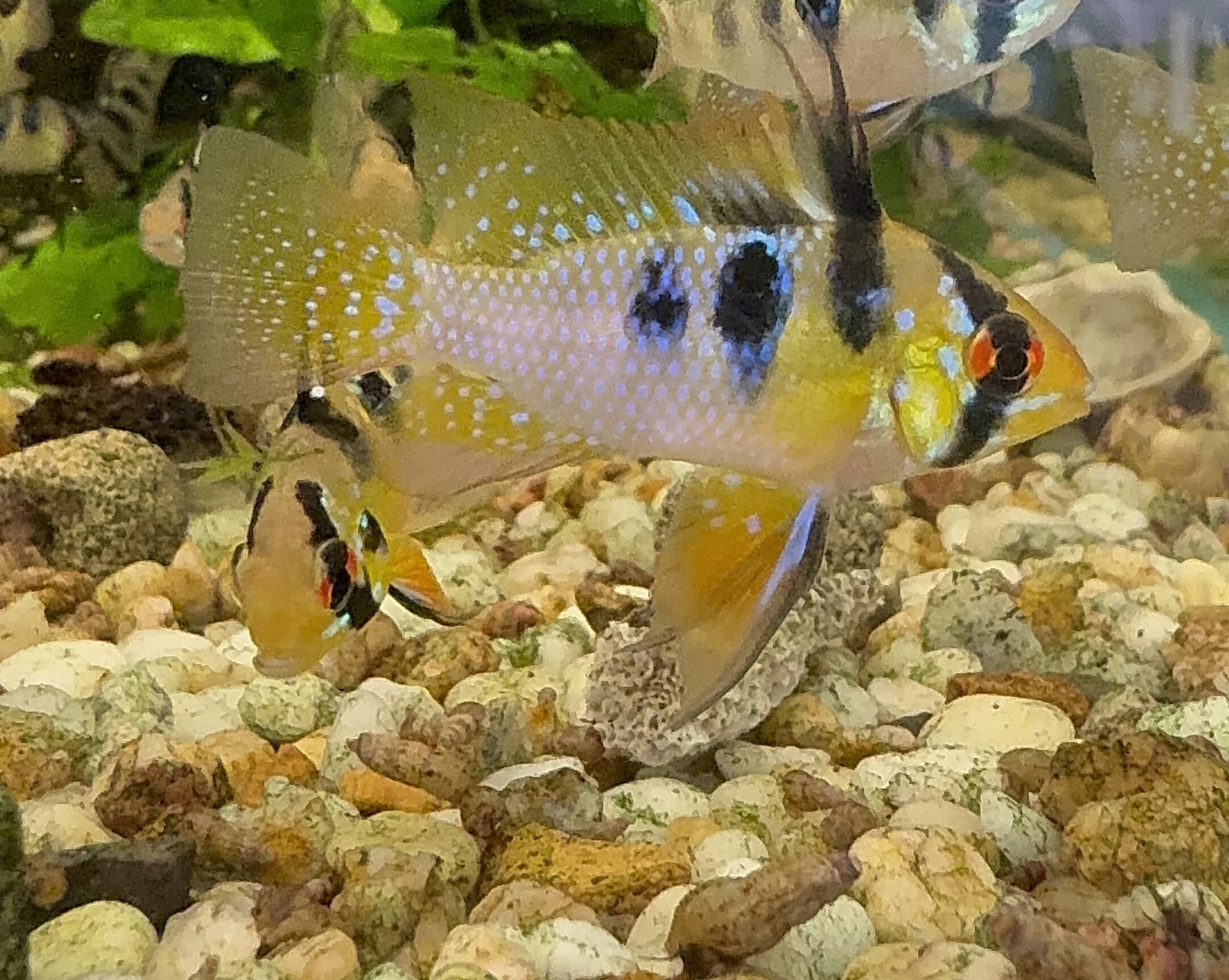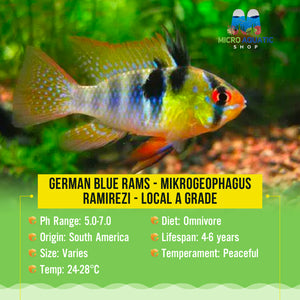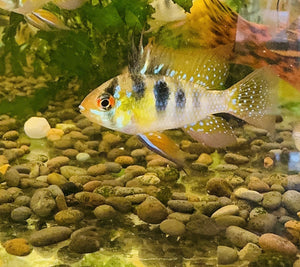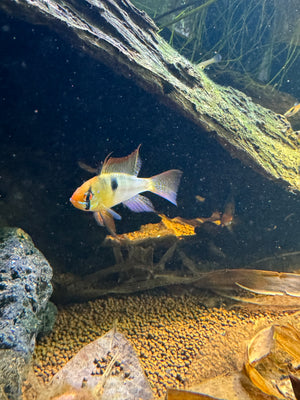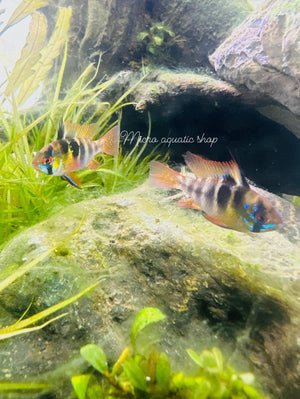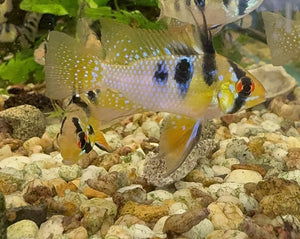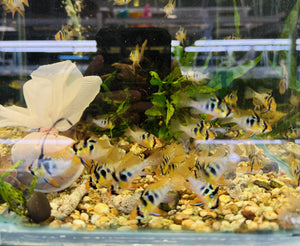German Blue Rams - Mikrogeophagus ramirezi
Guarantee Safe Checkout
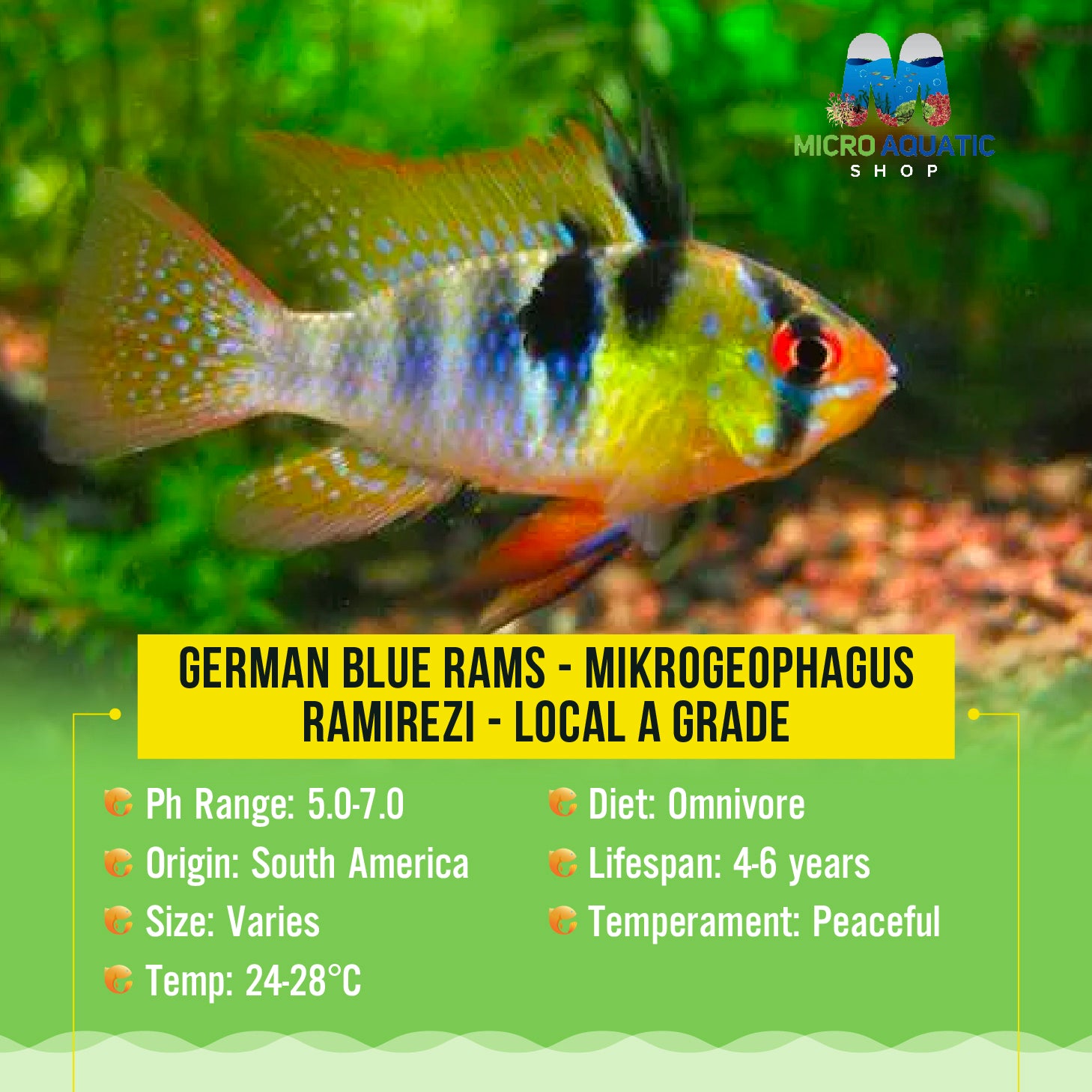
German Blue Rams - Mikrogeophagus ramirezi
German Blue Rams - Stunning Freshwater Cichlids for Your Tank
In Australia, we love the German Blue Ram, or Mikrogeophagus ramirezi. It's a dwarf cichlid that many adore. These fish are not just beautiful but also easy to care for in our tanks.  The German Blue Ram comes from South America's warm waters. They have bright blue and yellow colours, a unique shape, and amazing swimming. They are a joy to watch, whether you're new to aquariums or have been keeping them for years. In this guide, we'll dive into the German Blue Ram's world. We'll look at where they come from, what they look like, and why they're great tank mates in Australia.
The German Blue Ram comes from South America's warm waters. They have bright blue and yellow colours, a unique shape, and amazing swimming. They are a joy to watch, whether you're new to aquariums or have been keeping them for years. In this guide, we'll dive into the German Blue Ram's world. We'll look at where they come from, what they look like, and why they're great tank mates in Australia.
Key Takeaways
- The German Blue Ram is a captivating dwarf cichlid species from South America
- Known for their vibrant blue and yellow colouration and mesmerising swimming patterns
- Ideal for freshwater aquariums, providing a stunning visual appeal
- Popular among Australian aquarists for their unique personality and easy-to-care-for nature
- Explore their origins, physical traits, and why they make a great addition to your home aquarium
Introduction to German Blue Rams: A Jewel of Freshwater Aquariums
The German Blue Ram, also known as the electric blue ram or blue ram cichlid, is a stunning dwarf cichlid. It has won the hearts of aquarium lovers all over the world. These mesmerising fish come from South America, where they live in the calm waters of the Orinoco and Amazon rivers.
Origins and Natural Habitat
The German Blue Ram, scientifically named Mikrogeophagus ramirezi, is from Venezuela and Colombia. They live in slow-moving streams and tributaries. Their home is filled with shallow, densely planted areas and driftwood. The water is soft, slightly acidic, and warm. This matches the tropical climate of their native region.
Physical Characteristics
German Blue Rams are small fish, reaching about 6 centimetres in length. Their vibrant blue and yellow colours, along with their sleek body, make them a visual delight. Both males and females have stunning hues, with males showing more intense colours.
Why Choose German Blue Rams
- Stunning, vibrant colouration that adds a touch of beauty to any tank
- Peaceful and community-friendly, making them suitable for a variety of aquarium setups
- Relatively small size, making them an excellent choice for compact or nano tanks
- Fascinating behaviours, such as their intricate courtship rituals and parental care
- Hardy and adaptable, as long as their specific water parameter requirements are met
With their captivating appearance and engaging personalities, it's no wonder the German Blue Ram is a jewel of the freshwater aquarium hobby. These dwarf cichlids are a must-have for any aquarist looking to add vibrant colour and graceful charm to their underwater oasis.
Setting Up the Perfect Tank Environment
Keeping German Blue Rams requires creating a tank that mirrors their natural habitat. This setup helps them thrive and showcases their vibrant colours and interesting behaviours. As fans of freshwater aquarium fish, we'll show you how to create the ideal tank for these charming cichlids. The tank size is key. German Blue Rams prefer a tank of at least 20 gallons, with 30 gallons or more being even better. This size provides enough room for swimming and setting up their territories. The substrate should be fine gravel or sand, as they love to burrow and search for food.
- Ideal tank size: Minimum 20 gallons, with a preference for 30 gallons or more
- Substrate: Fine gravel or sand
For plants, a densely planted tank is best. German Blue Rams do well in spaces with lots of hiding spots and visual breaks. This setup reduces stress and encourages natural behaviour. Java moss, Anubias, and Cryptocoryne are great options that add both cover and beauty.
| Plant Species | Benefits for German Blue Rams |
| Java Moss | Provides hiding spots and spawning substrate |
| Anubias | Adds visual interest and cover |
| Cryptocoryne | Creates a lush, natural-looking environment |
Remember to add decor like rocks, driftwood, and terracotta pots to mimic their river habitats. These elements not only look great but also offer more hiding spots and territories for your ram cichlids to enjoy. "A well-designed tank that replicates the German Blue Rams' natural environment is the foundation for their long-term health and happiness."
Water Parameters and Maintenance Requirements
Keeping German Blue Rams, also known as ram cichlid care, requires the right water conditions. These freshwater aquarium fish need a specific temperature, pH, and water hardness. Let's explore how to keep their habitat perfect.
Optimal Temperature Range
German Blue Rams love a warm water temperature of 24-28°C (75-82°F). This matches their natural South American home. It helps them stay healthy and vibrant.
pH and Hardness Levels
- Ideal pH range: 6.0-7.5
- Preferred water hardness: Soft to medium (2-15 dGH)
Keeping these conditions right helps your German Blue Rams thrive. They'll show off their beautiful colours.
Water Quality Management
- Change 25-30% of the water weekly to keep it fresh.
- Use a good filter to keep the water clean and free of harmful substances.
- Test the water regularly to check pH, temperature, and more.
- Avoid sudden changes in water conditions, as German Blue Rams are sensitive.
By following these water care tips, you'll create a great home for your ram cichlid friends.
Dietary Needs and Feeding Schedule
The mikrogeophagus ramirezi, or German Blue Rams, are a delight in our freshwater aquariums. It's important to know their diet and feeding times. These ram cichlid care pets need a balanced diet to stay healthy and vibrant.  In the wild, they eat a variety of foods like tiny crustaceans and plant matter. For our aquariums, we should mix high-quality flakes or pellets with live and frozen foods.
In the wild, they eat a variety of foods like tiny crustaceans and plant matter. For our aquariums, we should mix high-quality flakes or pellets with live and frozen foods.
- Flakes or pellets formulated for tropical fish, providing essential nutrients and proteins
- Live foods such as brine shrimp, bloodworms, and daphnia, which mimic their natural prey
- Frozen foods, including mysis shrimp and chopped seafood, for added variety
- Occasional vegetable matter, like blanched spinach or zucchini, to cater to their omnivorous needs
Feeding them small, frequent meals is best. Aim for 2-3 feedings a day. This way, they can eat in a few minutes. Avoid overfeeding to keep the water quality good. By meeting their dietary needs and feeding schedule, we help our mikrogeophagus ramirezi thrive. They will stay vibrant and healthy in our aquariums.
Breeding German Blue Rams Successfully
Enthusiastic aquarists looking to breed German Blue Ram cichlids will find joy in their spawning and caring for the fry. This guide will help you set up the perfect breeding tank. It will also show you how to care for these stunning fish through their reproductive cycle.
Breeding Tank Setup
To create the best environment for ram cichlid breeding, a 20-gallon tank is recommended. Use a soft, planted substrate and dense vegetation. Keep the water temperature between 82-86°F and the pH between 6.0-7.5. Make sure there are plenty of hiding spots and cover to keep the blue ram cichlid pair safe and comfortable.
Spawning Behaviour
Watching German Blue Rams court and spawn is fascinating. A successful pair will dance, flaring their fins and showing off their colours. The female will lay her eggs on a flat surface, like a rock or plant leaf. The male will then fertilise them.
Caring for Fry
- After the eggs hatch, the parents will protect and care for the fry.
- Feed the fry micro-foods, such as infusoria or freshly hatched brine shrimp, to keep them nourished.
- Keep the water quality high and avoid disturbing the breeding tank to help the fry grow and thrive.
By carefully setting up the breeding tank, noticing the spawning cues, and looking after the fry, you can successfully breed your own ram cichlid colony.
Compatible Tank Mates and Social Behaviour
Choosing the right tank mates for German Blue Rams is key. These beautiful dwarf cichlids are usually calm and prefer company. But, it's important to pick species that won't bother their fins. For a peaceful aquarium, pair German Blue Rams with calm, slow-moving fish. Good options include:
- Corydoras catfish
- Neon tetras
- Platies
- Guppies
- Rasboras
Avoid aggressive or loud fish that might stress your ram cichlids. Stay away from big cichlids, barbs, and some tetras. Also, avoid fish with long fins, as they might get nipped by your ram cichlid tank mates. German Blue Rams are generally peaceful and get along well with others. They have a social order and may show territorial behaviour, especially when they spawn. Males often posture and display to show who's boss.
| Compatible Tank Mates | Incompatible Tank Mates |
| Corydoras catfish | Larger cichlids |
| Neon tetras | Barbs |
| Platies | Some tetras |
| Guppies | Fish with long, flowing fins |
| Rasboras | Aggressive or boisterous species |
By picking the right ram cichlid tank mates and understanding their social ways, you can build a lively and peaceful tank. This will highlight the beauty and charm of these stunning freshwater cichlids.
Common Health Issues and Prevention
We love our German Blue Ram cichlids and want them to stay healthy. These fish can get sick, but we can stop it with the right steps. Keeping them well is key to their happiness in our tanks.
Disease Recognition
Knowing how to spot sickness in our fish is crucial. German Blue Rams can get ich, fin rot, and bacterial infections. Spotting white spots, frayed fins, or odd swimming can help us act fast.
Treatment Options
There are many ways to treat our fish's health problems. We can use special foods, water treatments, or even vet advice. It's vital to follow the right steps and get help when needed.
Preventive Measures
Preventing sickness is always better than treating it. A good tank environment, right food, and less stress help a lot. Regular water checks, changes, and a clean tank are essential for our fish's health. Knowing about health issues, spotting problems early, and taking steps to prevent them helps our fish live well. With the right care, our German Blue Rams will be a beautiful part of our aquariums for years.
Conclusion
The German Blue Rams (also known as Mikrogeophagus Ramirezi) are a true gem in the world of freshwater aquariums. These dwarf cichlids have vibrant colours and graceful movements. They are a popular choice for aquarium enthusiasts in Australia.  In this guide, we've covered the key aspects of caring for these delightful fish. We've talked about setting up the perfect tank environment and meeting their dietary needs. We've also discussed common health concerns. By following these best practices, aquarium owners can create a thriving habitat for their German Blue Rams. Whether you're a seasoned aquarist or new to the hobby, we encourage you to consider adding these stunning dwarf cichlids to your aquarium. With the right care and attention, German Blue Rams can thrive. They bring a unique and captivating element to your underwater oasis. For all your aquarium needs, including high-quality fish and supplies, trust Micro Aquatic Shop, a trusted source for aquarium enthusiasts in Australia.
In this guide, we've covered the key aspects of caring for these delightful fish. We've talked about setting up the perfect tank environment and meeting their dietary needs. We've also discussed common health concerns. By following these best practices, aquarium owners can create a thriving habitat for their German Blue Rams. Whether you're a seasoned aquarist or new to the hobby, we encourage you to consider adding these stunning dwarf cichlids to your aquarium. With the right care and attention, German Blue Rams can thrive. They bring a unique and captivating element to your underwater oasis. For all your aquarium needs, including high-quality fish and supplies, trust Micro Aquatic Shop, a trusted source for aquarium enthusiasts in Australia.
FAQ
What is the natural habitat of German Blue Rams?
German Blue Rams live in the slow-moving streams of South America. They are found in the Orinoco and Amazon river basins. They love warm, soft, and slightly acidic waters.
What are the physical characteristics of German Blue Rams?
These fish are known for their electric blue colour. They have a compact body and long fins. Males are more colourful and have bigger fins than females.
Why are German Blue Rams a popular choice for freshwater aquariums?
They are loved for their beauty, calm nature, and small size. They fit well in many tank setups. They're great for community aquariums and add elegance.
What are the ideal water parameters for German Blue Rams?
They prefer warm water, between 24-30°C. The water should be soft and slightly acidic, with a pH of 6.0 to 7.5. Keeping the water stable is key for their health.
What should I feed German Blue Rams?
They eat a mix of flakes, pellets, and live foods. High-quality foods help them stay colourful and healthy. A balanced diet is important.
Can German Blue Rams be successfully bred in an aquarium?
Yes, they can be bred in a home aquarium. They need a special breeding tank with soft, acidic water. Watching their courtship and caring for the fry is crucial.
What are some suitable tank mates for German Blue Rams?
They are peaceful and can live with small, calm fish. Good tank mates include neon tetras and dwarf rasboras. Avoid aggressive or big fish.
How can I prevent and treat health issues in German Blue Rams?
They can get ich, fin rot, and bacterial infections. Keeping the water clean and treating diseases quickly is important. Use the right medication and ask for help if needed.
| Quantity |
1 ram ( random sex 2-3cm ), 1 pair ( 1 male 1 female ) 2-3cm, 1 trio ( 1 male 2 female ) 2-3cm |
|---|

